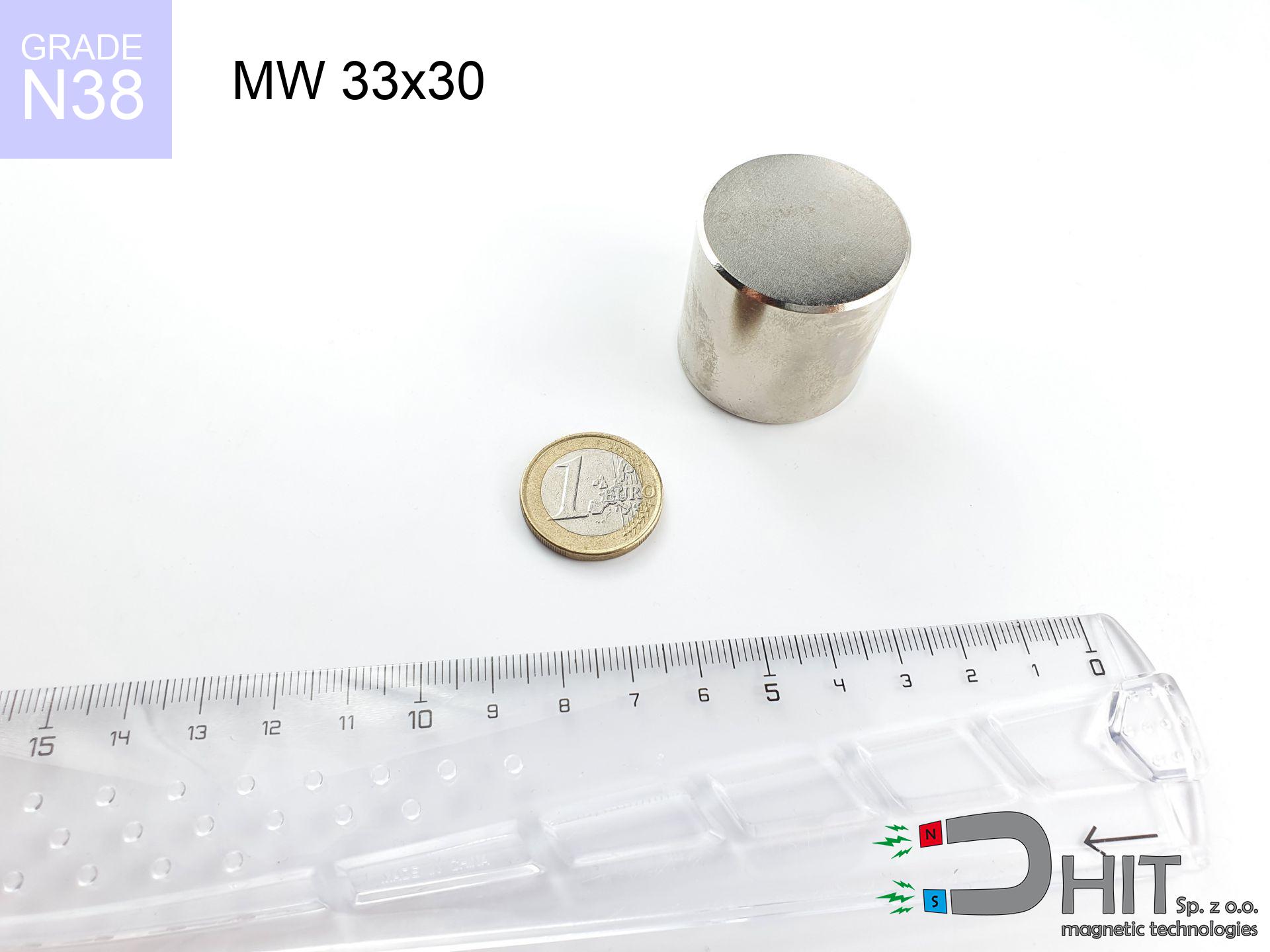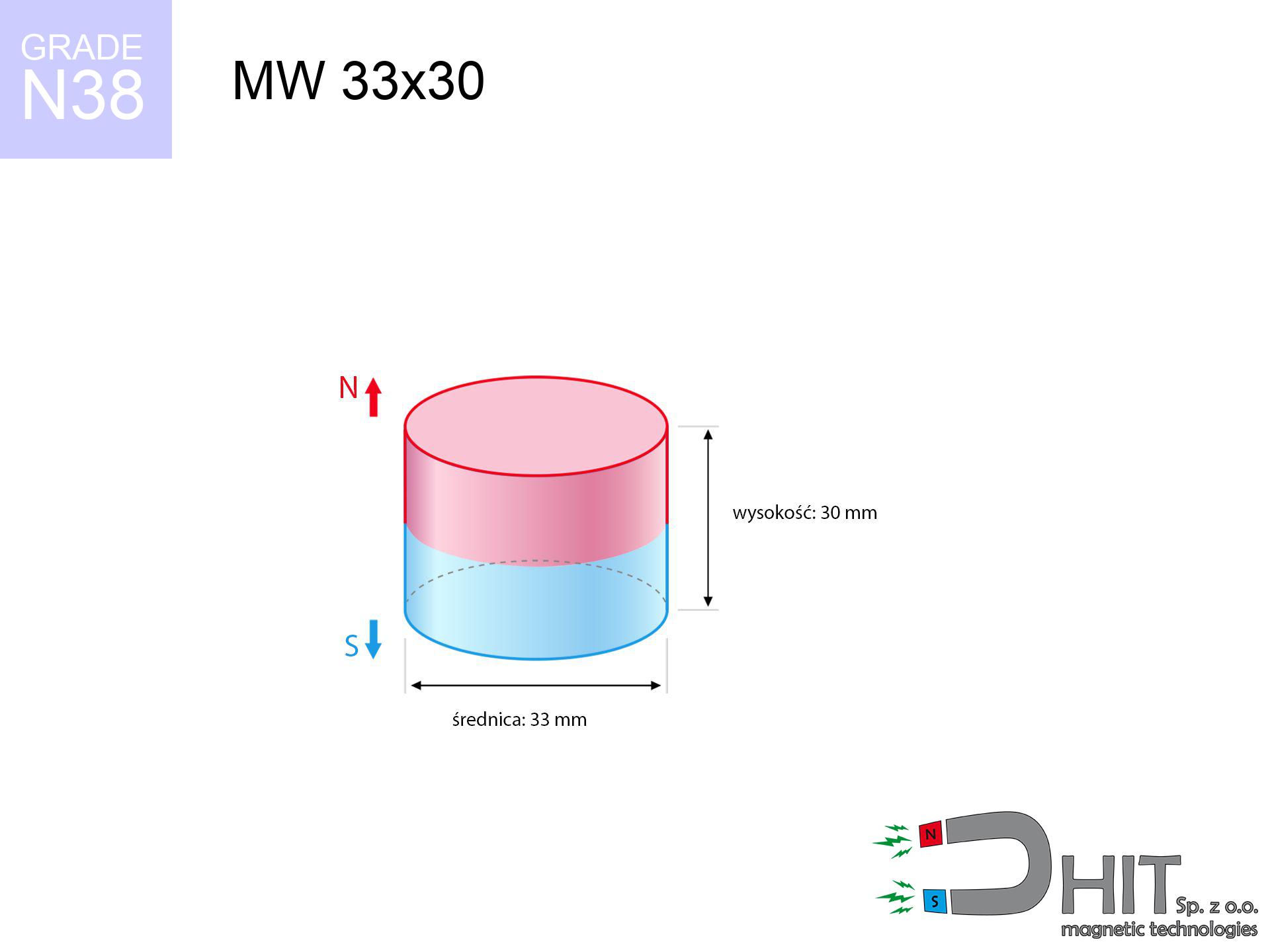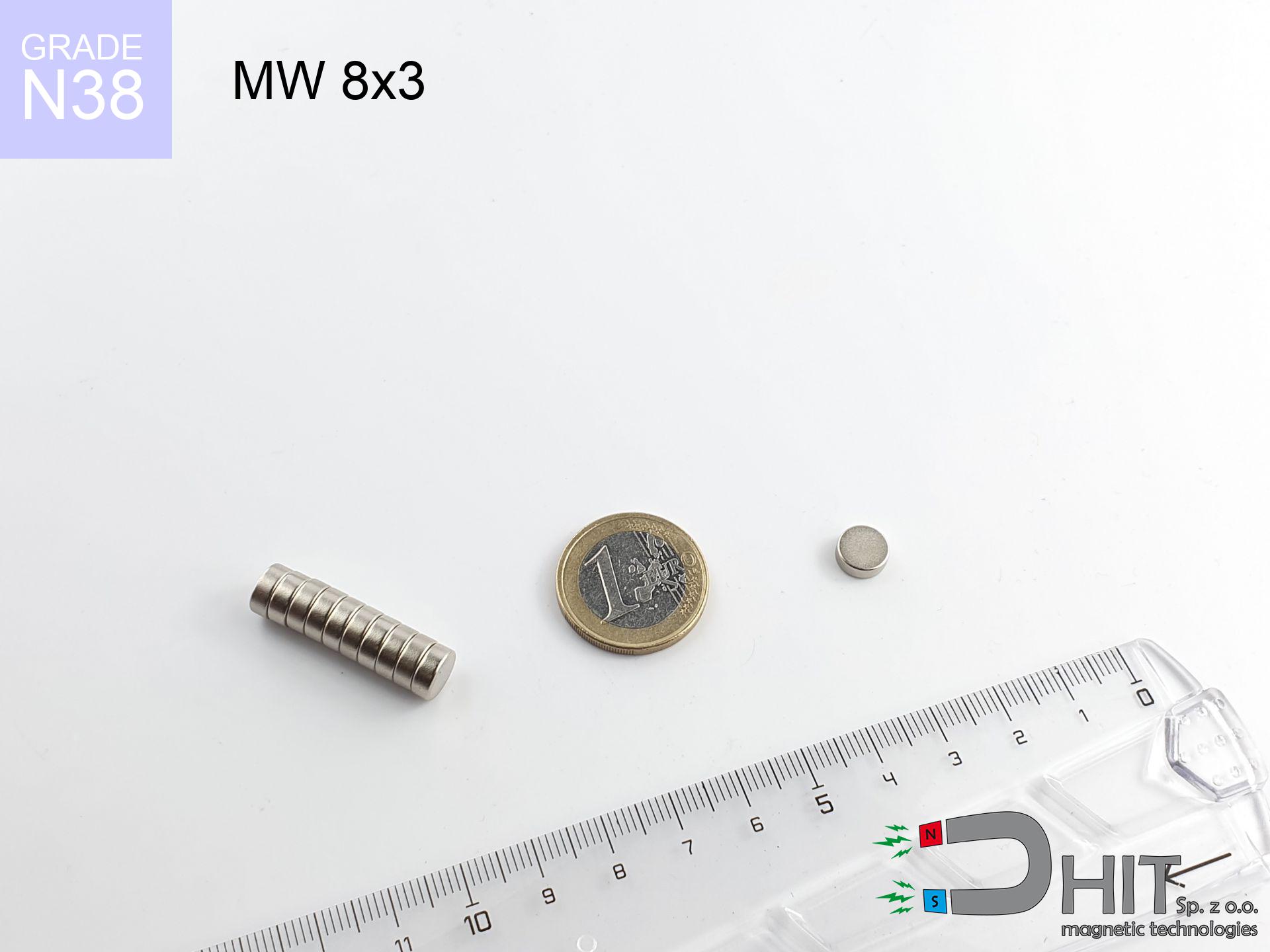MW 33x30 / N38 - cylindrical magnet
cylindrical magnet
Catalog no 010058
GTIN: 5906301810575
Diameter Ø [±0,1 mm]
33 mm
Height [±0,1 mm]
30 mm
Weight
192.44 g
Magnetization Direction
↑ axial
Load capacity
54.74 kg / 536.82 N
Magnetic Induction
543.05 mT
Coating
[NiCuNi] nickel
52.89 ZŁ with VAT / pcs + price for transport
43.00 ZŁ net + 23% VAT / pcs
bulk discounts:
Need more?Looking for a better price?
Call us
+48 22 499 98 98
if you prefer get in touch by means of
contact form
the contact page.
Specifications along with appearance of a magnet can be analyzed using our
power calculator.
Orders submitted before 14:00 will be dispatched today!
Magnetic properties of material N38
Physical properties of sintered neodymium magnets Nd2Fe14B at 20°C
Shopping tips
Strengths and weaknesses of NdFeB magnets.
Besides their high retention, neodymium magnets are valued for these benefits:
- They retain full power for around ten years – the drop is just ~1% (based on simulations),
- Neodymium magnets are distinguished by extremely resistant to loss of magnetic properties caused by external magnetic fields,
- Thanks to the metallic finish, the coating of nickel, gold, or silver gives an modern appearance,
- The surface of neodymium magnets generates a concentrated magnetic field – this is a key feature,
- Due to their durability and thermal resistance, neodymium magnets can operate (depending on the shape) even at high temperatures reaching 230°C or more...
- Possibility of custom forming and optimizing to complex requirements,
- Significant place in future technologies – they are used in data components, drive modules, precision medical tools, also other advanced devices.
- Relatively small size with high pulling force – neodymium magnets offer strong magnetic field in tiny dimensions, which allows their use in miniature devices
Disadvantages of neodymium magnets:
- They are fragile upon too strong impacts. To avoid cracks, it is worth securing magnets in special housings. Such protection not only protects the magnet but also increases its resistance to damage
- Neodymium magnets decrease their force under the influence of heating. As soon as 80°C is exceeded, many of them start losing their power. Therefore, we recommend our special magnets marked [AH], which maintain durability even at temperatures up to 230°C
- Due to the susceptibility of magnets to corrosion in a humid environment, we recommend using waterproof magnets made of rubber, plastic or other material resistant to moisture, in case of application outdoors
- Limited possibility of making threads in the magnet and complex forms - preferred is casing - magnetic holder.
- Possible danger resulting from small fragments of magnets pose a threat, when accidentally swallowed, which becomes key in the aspect of protecting the youngest. Additionally, tiny parts of these products are able to disrupt the diagnostic process medical after entering the body.
- High unit price – neodymium magnets cost more than other types of magnets (e.g. ferrite), which increases costs of application in large quantities
Maximum lifting capacity of the magnet – what affects it?
The lifting capacity listed is a result of laboratory testing executed under specific, ideal conditions:
- with the use of a sheet made of low-carbon steel, guaranteeing maximum field concentration
- whose transverse dimension is min. 10 mm
- characterized by even structure
- without any insulating layer between the magnet and steel
- during detachment in a direction perpendicular to the mounting surface
- at temperature approx. 20 degrees Celsius
Determinants of practical lifting force of a magnet
In practice, the real power depends on many variables, ranked from the most important:
- Distance (between the magnet and the metal), as even a microscopic distance (e.g. 0.5 mm) results in a decrease in force by up to 50% (this also applies to varnish, corrosion or debris).
- Force direction – declared lifting capacity refers to pulling vertically. When slipping, the magnet exhibits much less (often approx. 20-30% of maximum force).
- Base massiveness – insufficiently thick steel causes magnetic saturation, causing part of the power to be escaped into the air.
- Material composition – different alloys attracts identically. Alloy additives worsen the interaction with the magnet.
- Plate texture – ground elements guarantee perfect abutment, which improves field saturation. Uneven metal weaken the grip.
- Temperature – temperature increase results in weakening of force. Check the thermal limit for a given model.
* Holding force was measured on a smooth steel plate of 20 mm thickness, when a perpendicular force was applied, however under attempts to slide the magnet the holding force is lower. Additionally, even a slight gap {between} the magnet and the plate lowers the lifting capacity.
H&S for magnets
Product not for children
NdFeB magnets are not suitable for play. Eating a few magnets may result in them attracting across intestines, which poses a critical condition and necessitates urgent medical intervention.
Thermal limits
Avoid heat. NdFeB magnets are susceptible to temperature. If you need resistance above 80°C, inquire about special high-temperature series (H, SH, UH).
Magnetic media
Avoid bringing magnets near a wallet, computer, or TV. The magnetism can irreversibly ruin these devices and wipe information from cards.
Phone sensors
Be aware: neodymium magnets generate a field that interferes with precision electronics. Keep a safe distance from your mobile, device, and GPS.
Allergy Warning
Nickel alert: The nickel-copper-nickel coating contains nickel. If skin irritation appears, immediately stop handling magnets and wear gloves.
Fire warning
Combustion risk: Neodymium dust is highly flammable. Do not process magnets in home conditions as this may cause fire.
Implant safety
Warning for patients: Strong magnetic fields affect medical devices. Keep at least 30 cm distance or request help to work with the magnets.
Crushing force
Danger of trauma: The pulling power is so immense that it can cause blood blisters, pinching, and even bone fractures. Protective gloves are recommended.
Fragile material
Neodymium magnets are ceramic materials, which means they are fragile like glass. Impact of two magnets will cause them shattering into shards.
Powerful field
Handle magnets with awareness. Their powerful strength can shock even experienced users. Stay alert and respect their power.
Caution!
Learn more about hazards in the article: Magnet Safety Guide.






![SM 25x100 [2xM8] / N52 - magnetic separator SM 25x100 [2xM8] / N52 - magnetic separator](https://cdn3.dhit.pl/graphics/products/sm-25x100-2xm8-fin.jpg)
![UMGZ 60x30x15 [M10] GZ / N38 - magnetic holder external thread UMGZ 60x30x15 [M10] GZ / N38 - magnetic holder external thread](https://cdn3.dhit.pl/graphics/products/umgw-60x30x15-m10-gz-bas.jpg)

